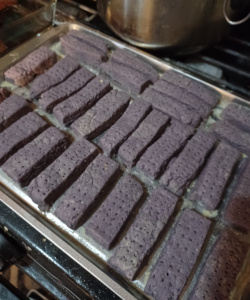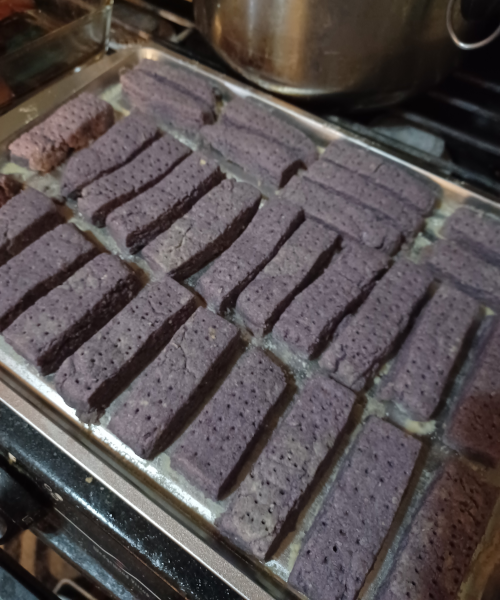Sorghum and Corn Shortbread Recipe


We grow drought tolerant corn and sorghum because annual precipitation is usually less than 12″, consists mostly winter snow (latitude 48N) and our well only provides 1/2 gal per minute. When we first harvested our grain sorghum we tried various cooking methods. Steaming like rice works well but wanted something to use as a snack. Searching around for other recipes using sorghum usually included use of AP flour with sorghum as a sweetener and few recipes that actually use sorghum flour.
Experimentation
First we made shortbread using finely ground unsieved blue corn flour which turned out well though it had more fiber than traditional Scottish shortbread, like something you might get at a health food bakery.
The next batch we I used a recipe that called for wheat and corn flour but substituted sorghum flour for the wheat flour. The shortbread tasted good but was crumbly and had a (health food) sandy texture. It was popular and didn’t last long on the baking sheet, but it could be improved!
African recipes use corn and sorghum flour to make Ugali where a corn and sorghum flour mix is added to boiling water with a bit of oil and left to steam in a covered pot. We followed this procedure using 1 cup of water with 1 cup for corn flour and 1 cup of sorghum flour with added butter and sugar. We also tried adding fennel powder, vanilla extract, and almond extract to give it a biscotti flavor. This bound together better but was heavy and probably not cooked enough even after 45 minutes, the taste was more like half-cooked oatmeal cookies. We baked it again in individual pieces and the water seemed to push the butter out of the shortbread and it was crumbly. Even after the second baking it still had a residual mushy oatmeal/wheathearts texture and the first 100% sorghum sandy version was more popular.
The idea is to precook the sorghum to get it to absorb water but not cook the corn as much. Corn is important as it binds the mixture together while shortbread made with just sorghum flour is too crumbly. Regular shortbread recipes do not add water and if too much water is added to the sorghum the texture isn't right. So add some water, but not too much.
With the next version we skipped the additional flavorings, used less water (1/2 a cup) for cooking the sorghum, added the butter and corn flour in a second stage, and baked longer. It came out perfect!
Corn & Sorghum Shortbread Ingredients
- 2 cups Sorghum Flour (we used Ba Ye Qi, finest grind setting with Komo mill, finely sieved).
- 1.5 cup Corn Flour (we used Hopi Blue Flour Corn, finest grind, finely sieved).
- 3 cubes salted butter
- 3/4 cup of white sugar
- 1/2 cup of water
Cooking Corn & Sorghum Shortbread
- Bring 1/2 cup of water and 1-2 cubes of butter to boil and add 2 cups of sorghum flour one cup at a time mixing well on lowest heat. Cook on lowest heat 1-2 minutes continuously stirring then compress the mixture on the bottom of the pot into a 1-2 inch layer.
- Cover tightly and leave on lowest heat for another 1-2 minutes, not longer or it will burn.
- Let stand covered for 30-60 minutes so the sorghum absorbs water and precooks.
- Add remaining of butter, 3/4 cup of sugar, and mix till even consistency.
- Add 1 cup for corn flour, and mix well till even consistency.
- Add extra corn flour and mix well to achieve a smooth shortbread dough consistency, usually about 1/2 cup.
- Spread and press into a 1/2 inch layer on a 9″ x 13″cookie sheet, score into squares, and poke generously with a fork.
- Bake at 300 F for 45 minutes to dry it out followed by another 45 minutes at 350F. The sorghum we used is from a red Ba Ye Qi and the corn flour from a Blue Hopi Flour corn so color is not useful to indicate when done. Poke it with a toothpick to see if it comes out clean.
It may be possible to change the final baking regimen as we had planned to try 325 F for 45 min. but the temperature was set incorrectly at 300F and so we added another 350F for 45 minutes. This came out perfect though as typical of shortbread it was a little crumbly. It was definitely not as sandy in texture. The taste and texture was similar to Scottish shortbread made with AP flour.